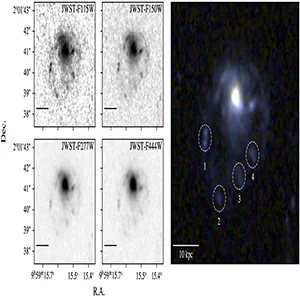
Webb Telescope discovers a strange galaxy that looks like a jellyfish floating in space
Jellyfish galaxies are rare cosmic sights where a spiral or disk galaxy trails a luminous tail of gas and new stars across space. That tail forms when the galaxy rams through hot cluster gas and loses its own fuel in a shimmering wake.
Astronomers using the James Webb Space Telescope (JWST) spotted one such creature on June 23, 2025, naming it COSMOS2020-635829, and they caught it nearly 8 billion years in the past at a redshift of 1.156.
A redshift is a way astronomers measure how far away an object is in the universe. The higher the redshift, the longer its light has been traveling through expanding space to reach us.
Lead author Ian D. Roberts of the University of Waterloo and colleagues pieced together the find from Webb images and ground-based spectroscopy.
Jellyfish galaxy COSMOS2020-635829
This jellyfish galaxy owes its shape to ram pressure stripping, the same aerodynamic drag that pushes air against your hand outside a moving car.
The mechanism was first laid out by scientists in 1972, who showed that a galaxy’s gas will be swept away if the external pressure exceeds the galaxy’s own gravity.
That external push comes from the intracluster medium, a thin plasma that can reach millions of degrees. When a galaxy plunges through this soup at hundreds of miles per second, gas peels off, ignites bursts of star formation, and builds the glowing tentacles captured in Webb’s pictures.
Jellyfish systems provide a front-row seat to “environmental quenching,” the process that shuts down star formation in crowded clusters long before galaxies would naturally age out.
Until recently the most distant confirmed jellyfish stood at redshift 0.7 in a cluster studied by astronomer Alessandra Boselli, leaving a 5 billion year gap in the record.
Catching one past redshift 1 means researchers can now link today’s dead cluster galaxies to the vigorous epoch when the universe made stars at its peak.
How Webb spotted the cosmic jelly
Webb’s NIRCam instrument, operating for the COSMOS-Web survey, delivered four infrared snapshots that reveal a tidy stellar disk plus a unilateral smear of bright blue knots. Each knot shines where stripped gas condensed into newborn stars.
“We report the discovery of COSMOS2020-635829 as a likely jellyfish galaxy…” wrote Roberts at the end of the analysis.
Spectra from the Gemini North telescope show ionized oxygen streaming more than 65,000 light-years beyond the disk.
The southern tail contains four main clumps, each roughly ten times the mass of the Orion Nebula but far younger.
Their combined mass equals about one percent of the parent galaxy, yet they sparkle with the vitality of a modest dwarf galaxy.
The tail glows with the same kind of light as the gas in the galaxy’s main body, showing it came from the galaxy and is now slowly drifting away at about fifty miles per second.
Ram pressure on COSMOS2020-635829
During “cosmic noon,” around 10 billion years ago, galaxies on the star-forming main sequence were converting gas to stars ten times faster than they do today.
Stripping some of that gas on the cluster outskirts may explain why many satellites stopped growing so quickly despite the overall boom.
By draining the gas reservoir, stripping forces galaxies onto a one-way road toward the red, quiescent population that dominates today’s rich clusters.

Observing the transition in real time helps astronomers calibrate models that track how long quenching takes and how much mass a galaxy can lose before star formation sputters out.
The Webb discovery also illustrates that stripping is not merely a gentle pruning. The tail’s star-formation rate, about a third of a solar mass per year, rivals small local galaxies, hinting that metal-rich stars can seed the cluster’s intracluster light or even grow self-contained dwarf systems.
Lessons from the tail
Local examples in the Virgo Cluster show tiny star clusters forming in stripped wakes, but they top out at a hundred thousand solar masses.
COSMOS2020-635829’s knots weigh one hundred million solar masses apiece, suggesting that early-universe conditions favored more robust construction projects.
If gravity keeps these clumps intact, they could fade into dark-matter-poor dwarf galaxies wandering the cluster like cosmic driftwood.
If turbulence tears them apart, their stars will leak into the vast intracluster glow that envelopes every mature cluster.
Computer simulations predict both outcomes depending on the clump mass, orbit, and the density of surrounding plasma.
Measuring sizes and motions of the tail sources with future Webb spectroscopy will test whether they are bound or doomed.
Either way, the parent galaxy is losing the raw material that fuels its prodigious hundred-solar-mass-per-year starburst.
Within a few hundred million years, the main disk may look more like a smooth-armed spiral than a stellar fireworks factory.
Looking ahead
COSMOS2020-635829 is not alone. Earlier this year, observers used ALMA to spot elongated molecular tails in nine galaxies inside a forming cluster 11 billion years away, offering a complementary view of stripping’s cold-gas phase.
Combining Webb’s infrared acuity with radio arrays such as ALMA and the upcoming ngVLA will let researchers map how different gas phases are removed and recycled.
Each wavelength fills in another layer of the process, from hot x-ray plasma to cold molecular clouds.
Future deep Webb images will also probe whether more subtle jellyfish lurk in the same field, allowing astronomers to trace how stripping frequency changes with cluster mass and cosmic time.
For now, COSMOS2020-635829 stretches a bright tendril into the cosmic past, showing that harsh cluster weather has shaped galaxy evolution for most of the universe’s history.
The study is published in arXiv.
—–
Like what you read? Subscribe to our newsletter for engaging articles, exclusive content, and the latest updates.
Check us out on EarthSnap, a free app brought to you by Eric Ralls and Earth.com.
—–













